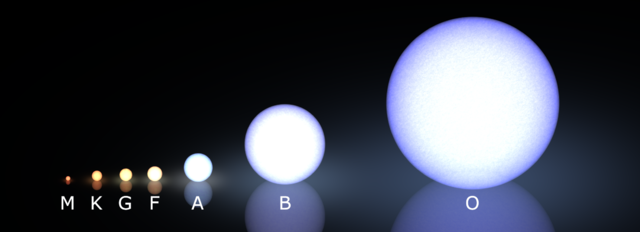 |
This is a file from the Wikimedia Commons. Information from its description page there is shown below.
Commons is a freely licensed media file repository. You can help.
|
Summary
Image depicting the Morgan-Keenan-Kellman spectral classification of main-sequence stars (1943). Sizes taken from the table at the stellar classification article on the English Wikipedia.
Some notes:
- These are main sequence stars only.
- The "floor" is there so we can compare the amount and colour of light coming from each star. The light intensity isn't proportional (that'd be rather intense), but is somewhat related to the actual ones.
- Larger stars show more colour since these output a lot more on the invisible spectrum. I tried to convey this by making them less white in the middle.
- The star's smoothness and the floor reflection were aesthetic choices.
Rendered using POV-Ray.
Derivative works of this file:
Licensing
I, the copyright holder of this work, hereby publish it under the following license:
 |
Permission is granted to copy, distribute and/or modify this document under the terms of the GNU Free Documentation License, Version 1.2 or any later version published by the Free Software Foundation; with no Invariant Sections, no Front-Cover Texts, and no Back-Cover Texts. A copy of the license is included in the section entitled GNU Free Documentation License. http://www.gnu.org/copyleft/fdl.htmlGFDLGNU Free Documentation Licensetruetrue
|
|
File usage
The following pages on Schools Wikipedia link to this image (list may be incomplete):
SOS Children chose the best bits of Wikipedia to help you learn. SOS Children's Villages works in 133 countries and territories across the globe, helps more than 62,000 children, and reaches over 2 million people in total. Try to find out how you can help children in other countries on our web site.




